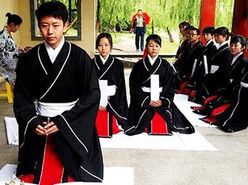
| ||||||||||||||||||||||||||||||||||||||||||||||||
| Total population | ||||||||||||||||||||||||||||||||||||||||||||||||
|---|---|---|---|---|---|---|---|---|---|---|---|---|---|---|---|---|---|---|---|---|---|---|---|---|---|---|---|---|---|---|---|---|---|---|---|---|---|---|---|---|---|---|---|---|---|---|---|---|
| 1,310,158,851 | ||||||||||||||||||||||||||||||||||||||||||||||||
| Regions with significant populations | ||||||||||||||||||||||||||||||||||||||||||||||||
| ||||||||||||||||||||||||||||||||||||||||||||||||
| Languages | ||||||||||||||||||||||||||||||||||||||||||||||||
|
Standard Chinese, Mandarin, Hokkien, Cantonese, other Chinese languages and vernacular languages of diaspora nations | ||||||||||||||||||||||||||||||||||||||||||||||||
| Religion | ||||||||||||||||||||||||||||||||||||||||||||||||
|
Chinese folk religions, Mahayana Buddhism, Christianity, Confucianism, Taoism, Animism, atheism and non-religious |
The Han Chinese people (Chinese: 汉族 (simplified) 漢族/ 漢人 (traditional)) are a Sino-Tibetan ethnic group that is indigenous to East Asia, mostly in mainland China and Taiwan. The Han Chinese people constitute about 20% of the entire human population.
Chinese culture, history and influence is known to be one of the world's greatest, complex and most important, as China is regarded as one of the great civilizations for many of important scientists, artists, musicians, religious leaders and political leaders of many eras came from China. Chinese culture - from language, writing system, clothing, food, martial arts, lifestyles, and even politics, has influenced and shaped other cultures, such as Japanese, Korean, Vietnamese and Thai culture, and as far west as Latin America, specifically Peru, as well as the United States and Canada, both nations with heavily multi-racial and mult-cultural populations. Chinese culture predominates that of Taiwan and Singapore. Chinese influence and traces can also be found in Central Asian, Indonesian and Malay culture.
Ethnic Han Chinese also constitute one the largest diaspora populations, with almost every major global city containing "Chinatowns". Han Chinese are stereotypically among some of the most successful, in terms of education and income and dominate the financial industry in many countries, even those where ethnic Chinese constitute a minority.
These people consider themselves to be the descendants of the Yan and Huang Emperors. Chinese history is also dominated by a surge in arts, architecture, philosophy, martial arts, politics, religion, science and mathematics. Since Hans make up more than 90% of China's population, many times they are simply referred to as Chinese people. During the Age of Imperialism, the Chinese people were targets of European expansion marked by a European desire to get access to the products of Asia.
Etymology
The history of the Chinese people and of China and the Asia-Pacific region comes mostly towards dynastic periods; and comes to a very complex diversity as which dynasty or period ruled which. The term Han Chinese derives from the Han Dynasty. The Han Dynasty came after the Qin Dynasty and these two are the ones that united China. Han Chinese people also got the name from the Han Dynasty's king, Han Zhong. This is who Han Chinese people refer to as their great ancestor.
History
Early History
There are endless theorized and proposals as to were exactly Han Chinese people originated from. There are theories that the Chinese originated from a bloodline in the Middle East or perhaps even Central Asia. The Han Chinese themselves are closely confined to China and descended from a group of people who lived by the Yellow River known as the Huaxia people. The Han civilizations can be traced back several millennia and they are renowned by archeologists for their pottery, which was often made from bronze, bones, stones and jade and even emeralds.
Dynasties on the Chinese Mainland 2070 B.C.-1911 A.D.
Xia Dynasty 2070-1600 B.C.
The earliest recorded dynasty established by the Chinese were the Xia Dynasty (Chinese: 夏朝, circa 2070 B.C.-1600 B.C.). The earliest forms of a Chinese script were found through pictographs on oracle bones. Much of the Xia Dynasty is recorded through legends and folktales in China known as the Bamboo Annals (Chinese: 竹書紀年). Annals are historical contexts or even legends that organize events by year, though there are archaeological evidence of the existence. The dynasty was found by an emperor known as Yu the Great (Chinese: 大禹), who brought an end to the primitive lifestyles in China and introduced a political system known as the Abdication System, in which the new ruler is determined by phsyical abilities. Yu the Great was mostly famous for his ability to control floods.[16]
Shang Dynasty 1600-1046 B.C.
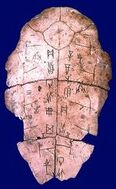
Ancient pictographs on oracle bones
The Shang Dynasty (Chinese: 商朝), circa 1600 B.C.-1046 B.C.) followed the Xia Dynasty and was found by a tyrannical ruler by the name of Jie (Chinese: 桀). According to legend, Shang Tang (Chinese: 成湯) overthrew the tyrant. After a period of oppression by Emperor Jie, the Shang Dynasty was marked by an era of improvement in farming that included the use of sickles and stone ploughs during an era known as the Bronze Age.[17] The Shang Dynasty is also where the first development of Chinese characters and symbols can be found which resembles the modern-day Hanza script. The Shang civilizations worshipped a god known as Shang Di (Chinese: 上帝), who was a supreme deity. The people of this dynasty were deeply religious and prepared for the afterlife, building elegant resting places for the deceased. Kings and royal members used oracle bones to communicate with ancestors, worshipping them and even making sacrifices which provides the backbone for the commong Chinese tradition of ancestor-worship.[18]
Zhou Dynasty 1046-256 B.C.
The Zhou Dynasty (Chinese: 周朝, circa 1046 B.C.-256 B.C.) saw the introduction of bronze and iron in China. According to Chinese history as well as overall historians, the Zhou Dynasty was one of China's longest-reigning,
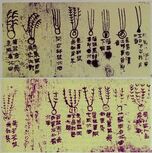
Bamboo Annals
especially for an early civilization and also brought an era of a unified government in China. Through military conquest, the Zhou Dynasty extended westward splitting into a western and an eastern administrative region. Confucius, a spiritual leader from what is now Tuo used the deteriorating traditional Chinese ways of government to spread his ideologies. This system was characterized by self-discipline and having a humble character in order to a ruler. The Zhuo dynasty later adopted his principles, and it eventually became the state religion of China.[19]
Han Dynasty & Three Kingdoms Era
Finally in around 206 B.C. came the Han Dynasty, in which the Han Chinese are allegedly named after. This dynasty was found by a peasant born as Liu Bang and later known by Emperor Goazu of Han. Bang rose to power after allying with the Chu clan, and overthrowing the peceding Qin dynasty in the Battle of Gaixia in 202 B.C. Emperor Goazu solidified control over the Chinese states, proclaiming himself as the Emperor of China and uniting most of it under his control. He also promoted Confucianism as the state religion, in addition to tax reductions and a type of unpaid and non-free labor known as corvée. Emperor Goazu divided the western half of his empire into political divisions known as commanderies and the eastern half was divided into vassal kingdoms. However, after a rebellion in 154 B.C. waged by seven of the kingdoms, in order to undermine the emperor and his centralization attempts, in which all of the Han empire was divided into commanderies. In 200 B.C., the nomadic Xiongnu led by the infamous Modu Chanyu, defeated the Hans in the Battle of Baideng. The Xiongnu practically subjagate the Han, and forced the Hans to send them goods as tributes. Despite treaties signed between the Han and the Xiongnu, the Xiongnu continued to attack Han territories. In 133 B.C., Emperor Wu, who began his reign in 141 B.C., launched a series of military offensives into Xiongnu territory after an assassination plot against the Xiongnu rulers failed. The Battle of Mobei, which took place where the Orkhon Valley in modern-day Mongolia is located, resulted in a Han victory and subjugation of the the Xiongnu.
Thanks to the Chinese diplomat Zhang Qian, China experienced mass contact and tade with civilizations outside of traditional Chinese realm, such as Central Asia, India and as far as the Roman Empire. More expansion and victory over the Xiongnu continued with succeeding emperors, leading into their expansion into Central Asia and from 115 to 60 B.C. the Han empire extended to the western and southern regions of China, and even into the Korean Peninsula.
The Han dynasty met a temporary downfall during the reign of Emperor Wang Mang, as a result, the era prior to Wang Mang's rule is known as the "Western Han dynasty" or "Former Han dynasty". Not only did Wang Mang's reign meet opposition, due to his promotion of equality and new currencies, but also by natural disasters such as the great floods between 7 A.D.-11 A.D., caused by silt buildups in the Yellow River.
On January 10, 9 A.D., Emperor Wang Mang established the Xin dynasty. Due to his incompetency, his was defeated and ovethrown by peasent rebels in 23 A.D. at the Battle of Chang'an. the victors would countinue the Han dynasty as the "Eastern Han" or "Latter Han".
After the Han Dynasty, unity in China was broken and the mainland fell under independent ruling families. This period of clan-rule in China was known as The Three Kingdoms era (Chinese: 三國時代 Sānguó shídài). The Chinese started to experience problems of military threats from the nomadic tribes up north from Siberia. This saw projects such as the Great Wall of China which took centuries or even millenia to progress and build.
Tang Dynasty 618-907 A.D.
China reached its golden age under the Tang Dynasty. This dynasty was founded by vassal of the former Sui Dynasty
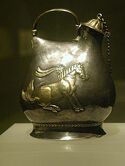
A Tang period gilt-silver jar, shaped in the style of northern nomad's leather bag
by the name of Li Yuan, who raised an army to battle against the tyrannical Sui emperor Yang in 617. In November of that year, his army captured the city of Chang'an, which today is the modern-day city of Xian. He then proclaimed himself as the prime minister and in 618, he siezed the oppurtunity to become new emperor of China after Yang was murdered by Yuwen Huaji, Emperor Yang's chancellor. When Taizong (Chinese: 唐太宗) became Chinese emperor of the Tang in 626, the empire entered the advent of a golden age. Taizong was a very wise emperor who led the nation into booming prosperity, and an extremely stable government and social system. Corruption
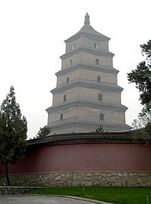
The Giant Wild Goose Pagoda, Chang'an (modern-day Xi'an), built in 652, repaired by Empress Wu Zetian in 704.
was non-existant under his rule either, and trade was opened to other nations. After his death, Li Zhi, his ninth son became emperor and marred his concubine, Wu Meiniang who was renamed Wu Zetian. She became the empress, and true control came through her since Emperor Li Zhi fell to sickness. After dethroning her two sons, she became the supreme empress of China and continued contributing to its boom. In 712, Li Longji, one of Wu Zetian's grandsons was enthroned as Emperor Xuanzong. Under his reign, the empire once-more reached a summit of prosperity.[20] During this dynasty, outside religions such as Christianity and Islam found their way into China as a result of open interactions with other nations. Chinese literature also blossomed in this era, giving rise to the famous poets Li Bai and Du Fu. Visual art also flourished and architecture, giving rise to many beautiful pagodas. The Tang Dynasty also introduced effeciant food-preserving tactics that diminished any form of famine in China.
Yuan Dynasty 1279-1368 A.D.
One of the most notorious periods in the history of the Han Chinese people is the Yuan Dynasty (Chinese: 元朝,
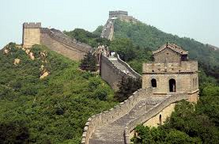
The Great Wall of China was built to protect from northern nomadic invasions
Mongolian: Их Юань улс) which lasted from 1279 A.D.-1368 A.D. After Genghis Khan united the Mongol tribes, they began to push south into China crushing the Song Dynasty armies. Kublai Khan, a grandson of Genghis Khan eventually took over China and formed the Yuan Dynasty. This was one of China's first dynasties where China was ruled by a non-Han Chinese emperor. It is both an imperial period in China's history and Mongolia's history. Kublai Khan was known as both the Great Khan (Mongolic/Turkic ruler) of the Mongol Empire and the Emperor of Yuan China, much of Kublai's respect for Chinese culture that he titled himself according to both Chinese and Mongol-traditions. The Yuan Dynasty was overthrown by Han rebels who according to Chinese legend, used moon cakes which contained messages of rebellious planning instead of blessings towards the Mongol rulers, which was the official purpose of moon cakes. After the Yuan Dynasty was defeated, the Chinese reversed the Mongol invasions and used military force against the Mongols. The remnants of the Mongol Empire were known as the Northern Yuan Dynasty as they retreated back to Mongolia and other parts of the Siberian region. In the 19th century A.D., the Chinese would find themselves jousting with the Japanese and Russian Empires for control of the Korean Peninsula. The first war occurred between the Qing Dynasty and Japanese.
Ming Dynasty 1368-1644 A.D.
In 1353, a Chinese peasant by the name of Zhu Yuanzhang (Chinese: 洪武帝) began a rebellion movement to overthrow the Yuan rulers of China tha the Yuan armies struggled to deal with. With local-upbringings of small militant
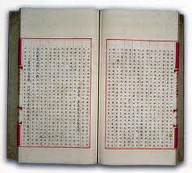
Pages from the Yongle Dadian
groups, the Chinese rebels eventually began established large strongholds in cities and claiming large amounts of territory. Yuanzhang was no exception, he joined the Red Turban Rebellion, which was started by an organization known as the White Lotus Society. In 1356, Zhu Yuanzhang was able to conquer the city of Nanjing, an important strategic point in which he could countrol the Yangtze Rver from. The Red Turban army eventually split into two factions, that rivalled from control over China. He led one faction against another, led by a general named Chen Youliang. In 1363, he defeated Chen's army and eliminated other resistances that followed. After he conquered Beijing, the Mongol remnants fled north back to Mongolia in what is now the Yunnan Province, which splintered in the Northern Yuan Empire. In 1368, he became emperor and started the Ming Dynasty, the word ming means "bright" in Chinese.[21] Emperor Zhu Yuanzhang implemented many policies that freed the peasants away from the burdensome they had faced during the Yuan-rule. The dynasty prospered under the ruler of Emperor Chengzu, Zhu Yuanzhang's fourth son. During his reign, the Yongle Dadian (Chinese: 永乐大典) was written which was regared to have become the world's largest and earliest encyclopedia. In 1405, the emperor hired a Muslim eunuch by the name of Zheng He to discover Southeast Asia, what is now Indonesia and Malaysia marking the dawn of Islam in those nations after converting large amounts of people.[22]
Gold Attracts Chinese Migrants to the United States 1800s
In th 1800s, many Chinese migrants began heading for the United States, in the western coasts. In 1849, an event in
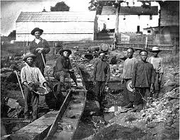
Chinese miners in California during gold rush
the United States known as the California Gold Rush attracted even more Chinese migrants to the American state of California in hopes of finding gold and striking it rich. It did not fare well for the Chinese people, many failed to find anything and worked in dangerous coal mines and railroad systems, dealing with dangerous explosive tools with little pay. Chinese migrants were processed at Angel Island. Conditions grew even more burdensom when the United States government passed the Chinese Exclusion Act of 1882, which placed restrictions against immigrants coming from China.[23]
Republic of China 1912-present
In 1644 A.D., the Qing Dynasty ruled China. Like the Yuan Dynasty, it was of non-Han origin as it was founded by an
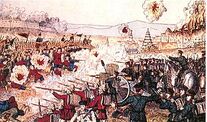
Depiction of British and Japanese forces fighting Chinese forces in the Battle of Tiensin
ethnic group from northeastern China known as the Manchus who had strong ties and influence with the Mongols. Instability ravaged the final years of the Qing dynasty, as foreign powers sought to aid those wanting to turn China into a democratic republic. The Righteous Harmony Society staged an uprising against foreign-support, in an event known as the Boxer Rebellion. These militants claimed in having supernatural abilities that would help them defeat foreign aid, but they were defeated by an alliance of European nation and their Chinese supporters. On 1911, a revolutionary army led by Huang Xing defeated Qing authority in the city of Wuchang. The latter and larger Xinhai Revolution ended in a revolutionary victory on February 12, 1912 that ended the dynastic rule in China, establish a republic, led mainly by Sun Yat-sen. The economic policies of this republic was still geographically divided. The north implemented a system in which people paid high taxes to land lords. Chiang Kai-shek (Chinese: 蔣介石), leader of a rivaling government in the south ended that with another revolution supported by the Soviet Union.
The Republic of China was exiled into Formosa, or Taiwan where it today, exists under the same name later on in 1949 after losing a civil war against the communists, led by Mao Zedong.
Sino-Japanese Wars
Korea, located on a peninsula located east of China was a trading stronghold of the Qing Dynasty. But to the south of Korea, an new up-start military power had its won interests with the peninsula, Japan. The Japanese army had a desire to prevent other powers from involving themselves with Korea. In 1886, Qing forces attacked Japanese forts. While the Chinese had the superior army and navy, the Japanese began to model their navy after Britain's and their army after the French. The Qing navy was decisively defeated at the Battle of Yalu.[24]. They were also defeated at Pyongyang and lost their own Weihaiwei. In 1895, the Qing Dynasty sued for peace after the crushing defeat, giving Japan control of Korea. In the 1930s, China (now a republic during this time) and Imperial Japan turned their attentions to Manchuria, which Japan established as a puppet state. Japan's conquering ambitions led for a desire to gain accesss to Manchuria's raw
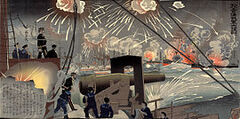
"Battle of the Yellow Sea" by Korechika
materials. On January 28, 1932, Chinese and Japanese troops fought in a scuffle in the city of Shanghai, ending a ceasefire and a dimilitarizing of Shanghai.[25] On 1937, Chinese and Japanese troops again exchanged volley fire in the Marco Polo Bridge. On December 13 of that year, Japanese forces entered Nanjing, China's former capital, massacring many unarmed citizens and even raping women as well as the looting of valuables. The Chinese armies failed to supress Japan's attacks, allowing Japan to conquer China, a conquest that persisted through the Second World War until Japan's surrender in 1945. China's armies also got support from the United States and the Soviet Union.
World War II
The second war occurred during World War II which was more atrocious, in which the Japanese Empire swept the entire Asia-Pacific area. By this time, Japan and China had become sworn military enemies. Japan was having a greater desire for a growing military, by gaining resources from other countries by force to feed its war machine. In 1937, Japan began its Pacific sweep by invading Manchuria and bombing Chinese cities with its air force. The worse atrocity occurred in the Chinese city of Nanjing were women were also raped by Japanese soldiers. From there on, most of China remained under Japanese control which resulted in the deaths of many innocent Chinese people. It isn't until around 1944-1945 that the Japanese lost their power allowing the Americans to help the Chinese and Koreans overthrew Japanese rule as a result of naval errors.
Chinese Civil War 1945-1949
The Second World War had made China a melting pot of aid from foreign supporters, that included the obvious and usual - United States, United Kingdom and the Soviet Union. The United States had used China as a standing ground for the war against Japan. Mao Tse-tung, commonly spelled as Mao Zedong (Chinese: 毛泽东) was the leader of a communist faction in China. After World War II, American general George C. Marshall handled peace plans between Zedong's communists and Cheng Kai-shek's nationalists. These peace plans failed, and a war would ensue between the communists and nationalists of China. Thanks to Mao Zedong and a clever strategy, the communist forces enjoyed an advatage in supplies and raw materials since they used Manchuria as a stage for their invasion. With the involvement of Soviet premier Joseph Stalin, the communist paused their advance as they approached the Great Wall and the Yangtze River. When western support dwindled to handle situations in China, Stalin finally let hte communists make their advance, thus gaining control of China and defeating the nationalists.[26]
People's Republic of China 1949-present
Cold War 1949-1991
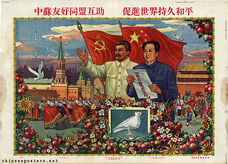
Sino-Soviet Treaty propaganda poster
In the immediete aftermath of World War II, the Soviet Union and the United States became top leaders in either hemisphere. The Soviets had the biggest military in the world but the United States contained the atombic bombs. The Chinese had their own part to play. In 1949, after his victory over the right-wing Nationlists of Cheng Kai-shek, Mao Zedong eliminated democracy and Japanese imperialism. He converted the government into a communist and Marxist-Leninist ideology expelling the Republic of China south into Taiwan. Under Zedong, the People's Republic of China was formed, and became a communist superpower of their own right. After the death of Joseph Stalin, Nikita Kruschev's decision to open relations with the West infuriated Mao Zedong, who saw Kruschev's decision as detrimental to true communism - which degraded into hostilities with the Soviet Union. This led to the Sino-Soviet split of 1968, and further deteriorated into the Sino-Soviet Border Conflict.
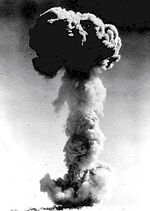
China detonates its first nuke, 1964
Eventually, China entered the global stage as a third power, competing against both the United States and the Soviet Union to spread a new section of communism historians refer to as Maoism, based on hardliner communism. The Chinese also entered the nuclear weapons stage, by successfully testing and detonating their own nuclear bomb in 1964. Like the Soviet Union, China funded communist factions during proxy wars and civil wars in other nations against pro-western and pro-Soviet groups. It played a key role in helping the North Koreans during the Korean War. It also funded the Cambodian regime under Pol Pot, in which Cambodia was considered a Chinese puppet state, and funded Cambodian operations against Vietnam, a Soviet puppet state. The fear of an all-out global nuclear war was prolonged when China and the Soviet Union engaged in a short military border conflict in 1969.[27] In 1972, American president Richard Nixon made his first visit to China and met premier Zhou Enlai, as a result of a desire to open and cool relations with the People's Republic.[28] It was also characterized by a friendly table-tennis match between Chinese and American players, forcing the Soviet Union to make diplomatic ties with the west.
China's transition into today's global power came during the leadership of Deng Xiaoping in 1978. Xiaoping encouraged Chinese citizens to work and study abroad, and bring back their knowledge to China, a trend among ethnic Chinese still seen today. Chinese economy open up to the West, peasants were give more rights and control over their land. Live improved for millions of Chinese citizens. It is thanks to Xiaoping's reforms that despite outwardly advocating communism, China is a free-market nation. In 1997, China acquired Hong Kong from the British Empire, which in a sense, marked the symbolic end of the British Empire. Over the decades, Chinese economy and military continue to grow, the People's Republic of China now has the world's second-largest GDP and fastest modernizing military, having the second largest military expenditure from the United States.
May 1998 Race Riots in Indonesia
In the wake of the 1990s, a disastrious financial era ravaged through Southeast Asia and criticisms against the New Order in Indonesia, the presidential regime of Suharto. Indonesia was one of the most devastasted nations out of these, and the fingers pointed towards ethnic Chinese Indonesians, due the predominantly Chinese-controlled economy. Violence towards Chinese Indonesians took place in Jakarta, Surakarta, and Medan in northern Sumatra. More than 400 Chinese-owned buildings and homes were burnt down during riots. Chinese Indonesians were victims of pillaging and looting, Chinese women were also victims of rape.[29]
Languages
Mandarin/Standard Chinese
China is home to over 292 languages and dialects; most being Sino-Tibetan and the others being either Turkic or Mongolic languages. The term Chinese language can either refer to the Standard Chinese language or the Sino-Tibetan languages indigenous to China. Han Chinese people speak a few languages on a standardized level. Most are bound by the Standard Chinese language, which is based on the Mandarin language itself. Mandarin is fairly indigenous to northern China. It is China and Taiwan's national languages. Mandarin is also spoken by the Han Chipnese communities in Malaysia, Singapore, Indonesia, United States and other communities in Southeast Asia and Australia. It is one of Singapore's four official languages.
Cantonese and Hokkien
Cantonese is China's second-most spoken local language and it indigenous to southern China. Cantonese is also spoken by overseas Chinese people. The Hokkien language is also indigenous to southern China, its speakers are known as Hoklo Chinese (Chinese: 福建人). The Hoklo people are considered Han Chinese, they make up the majority of Taiwan's Han population as well as the overseas Chinese in Malaysia, Singapore, Indonesia, Myanmar and the Philippines.
Other languages
There is also a minority that can speak the Spanish and Portuguese languages. The fluent Portuguese-speakers of China are from the state of Macau, once a Portuguese protectorate. The Chinese of Macau are highly embracive of the European influence, that the Portuguese language remained an official language of Macau along with Chinese. The Spanish language is spoken by the diaspora in Latin America and the elder Chinese-Filipino populations in the Philippines, who are known as mestizo de sangleys, where the word mestizo is a Spanish term used to describe people of mixed ancestry. This resulted from the Spanish conquest of the Philippines, during the colonial era, many of the Chinese already in Luzon became members of the Principalía, the elite and educated class of Philippine chiefs that willingly converted to Roman Catholicism. Most of the Principalía was in fact, consisted of these Chinese mestizos. Due to close economic ties between China and the United States, the English language is predominant in China's most-major cities and provinces that attracts tourists and American migrants workers as well as being the language of the Chinese American diaspora. English is also one of Singapore's official languages, exposing its majority-Chinese population to the language. In Indonesia and Malaysia, many of the overseas Chinese, while keeping an extent of cultural identity, have becoming linguistically assimilated into speaking only Indonesian or Malay.
Religion
Buddhism
Most of China's history is dominated by folk religions. Consequently, most Han Chinese people are practitioners of innumerable traditional folk religions in China. The predominant religion in China is Buddhism. Despite China having
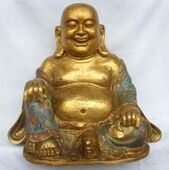
Statue of a loving Buddha
the largest Buddhist population, Buddhism is not indigenous to China; it was brought over from India and eventually became China's predominant faith. Buddhism is quite identical to the Vedic faith of Hinduism, much of it was stemmed from Hinduism. Guatama Buddha (Sanskrit: सिद्धार्थ गौतम बुद्ध) was an Indian monk of the Haryanka dynasty who was disgusted by the caste system of Hinduism. Buddha argued that one must abandon all earthly wants to reach enlightenment, as opposed to Hinduism's ethic where one's riches and wealth is determined by his caste or social class. Buddhists believe in reincarnation, the belief of being sent back and physically reborn after death. Most Chinese people practice the Mahayana section of Buddhism, a section also practiced in Southeast Asia. There also practitioners of Zen Buddhism. Despite being a Muslim country by majority, Buddhism is not foreign to Malaysia or even Indonesia or in fact, any of the Southeast Asian region, especially in the province and city of Penang in Malaysia where Buddhism has existed for millennia and has predated the existance of Islam. Buddhist temples and monastaries can also be found scattered in northern Borneo, in the Malaysian state of Sabah and Sarawak.
Confucioanism and Taoism
Confucianism and Taoism are also native to China. Confucianism was founded by Confucious, like Buddha, he was a spiritual leader but he was from China. Confucianism and Taoism are both philosophical movements rather than religions, that focus on human principles. Although Taoists do not venerate deities, their main center of focus is a mysterious universal entity known as the Tao. Like Buddhists; Taoists and Confucists practice the art of meditation and spiritual purity. Martial arts also bases many of its teachings from Taoism, the form known as Tai Chi originated from Taoism.
Christianity
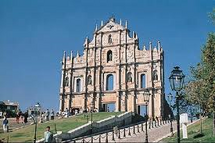
Ruins of Ruins of St. Paul's in Macau, China
There is also a large group practicing Christianity. The This was a result of Nestorian missionaries in China during the Tang Dynasty and the latter European expansion, by active Portuguese missionaries in China. Most of these are the overseas populations in Maritime Southeast Asia. Roman Catholicism is mainly practiced by the the overseas Chinese in Peru and the Philippines, Protestantism, as well as Evangelical and charismatic sections are mostly practiced by the diaspora in Indonesia and Malaysia. The Chinese Malaysians follow either. Many are descendants of refugees fleeing religious persecution in mainland China. Most of the overseas Chinese in Indonesia and the Philippines are overwhelmingly Christians, who practice a form of Folk Christianity, a hodge podge of Christian and traditional Chinese practices. Indonesian Chinese people make up a majority of Indonesia's Christians, which is a Muslim country by majority. In Malaysia, the Chinese follow a melting pot of religious, ranging from Buddhism, Taoism and Christianiy. Despite the large overseas Chinese Christian populations, Christianity is still one of China's main religions practiced by large amount of people, especially in the state of Macau which contains high Portuguese influence. In the United States, there is also a big minority practicing Christianity. In many cities, they establish churches for Chinese-speaking people. Additionally, Animism and nature-worship plays a crucial role in Chinese religions, regardless of religious affiliation. According to the Chinese calendar, each year is themed on a certain animal. This plays a key role in the strengths and weaknesses of a person.
Art and Architecture
Art
Chinese art is influenced by many factors, including religion, politics and nature. Out of the three, nature and religion
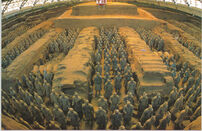
The Terracotta Army, this statue army of life-size soldiers built during the Qin Dynasty (c. 221 B.C.-206 B.C.) were found by farmers in the Lintong Province and is now a major world UNESCO site
dominate much of traditional Chinese art. Like Arabic art, although with no cultural resemblance, the nature in Chinese art is mostly floral designs. Unlike Arabic art, Chinese floral art is not generally symmetrical. Symmetrical Chinese art was more eminent with the early Chinese civilizations who mostly made vases and other pottery. Ancestor-worship is dominant in China. Chinese art also displays a great deal of folktales and legends. Chinese paintings of people were mostly portraits on a center of a papyrus page with inscriptions of Chinese characters on the top margins, a model later adopted by the Koreans which is known as a relief. For example, the only surviving visual evidences of Genghis Khan and Kublai Khan were paintings and portraits from Chinese and Vietnamese artists from the Yuan Dynasty. Mongol artists also adopted this style of art. The dragon is
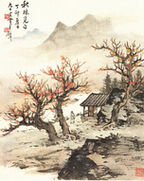
an element of Chinese culture and the many religious of China. Dragon art dominates Chinese art as well, which was later adopted by the Japanese people. Chinese art also consists of landscape paintings, also adopted by the other Asian civilizations in the east. Other than the dragon, animism and nature is also an important element of Chinese culture, each year is determined by an animal in the Chinese calendar. Sky-lantern art is very popular during Chinese and Southeast Asian festivals, which is a collapsible-balloon like piece of art that is flown which is decorated with Chinese calligraphies. Paper-lanterns resemble sky-lanterns, only that they are hung on thread and is common among Chinese communities around the world.
Music
Main Article: History of music in China at Music China Wiki
Main Article: Chinese music at Wikipedia
Architecture
Chinese architecture is dominated by religious influence from Buddhism; but China's Buddhist architecture does not bear much resemblance to those found in India or Southeast Asia. Buddhist architecture in China is influenced
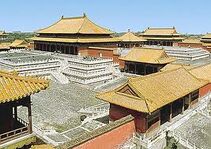
Forbidden City
from imperial influence, which usually contained a complex of three buildings that are each separated by a courtyard. The Feng Shui, a Chinese legend, determines which direction parts of a complex or a building, which determines the fate of those that preside or enter the building. The monastery, the main part of a Buddhist complex usually faces south. In the front hall, entrants are usually greeted by four wooden images which represent the guards of the four directions of the earth, known as Si-Tien Wang Tien as well as a statue of Buddha who is sometimes known as Maitreya.[30] One distinct part of these Buddhist temples are the roofs, which contain an overhanging eave before an
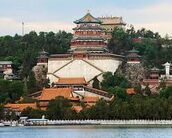
The vibrant Summer Palace
upward-slope. According to Chinese tradition from the Han Dynasty, this particular design was meant to ward-off evil spirits. The upward-slope is meant to carry spirits, that's where the Four Guardians are usually placed in Buddhist monasteries.[31] The pagoda, like the religion of Buddhism itself, was introduced to East Asia from India. The purpose of a pagoda resembled the role of a mausoleum, which was to preserve the remains of Buddhist relics.[32] Pagodas are tiered-tower like structures, in China, they satisfy Buddhist architecture. The architectural traditions of Buddhism in China have spread
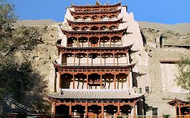
Mogao Caves
beyond to followers of other religions in China. For examples, churches - the places of Christian worship, and mosques - places of Muslim worship are built using completely traditional Chinese Buddhist style, not European or Arab influence. Due to this rich and sophisticated history of architecture, China contains many ancient fortresses that are now popular world UNESCO and tourist destinations. These include the Forebidden City in Beijing, the White Horse Temple in Henan from the Han Dynasty, the Summer Palace and the Mogao Caves in which Buddhist temples were carved into the rocks. Houses in China also resemble Buddhist architecture and face the south.
Cuisine
Han Chinese cuisine is either renowned for being pleasuring or for involving ingredients that westerners may find to be unpleasant. Staple meats in Chinese cuisine are beef, pork, fish, duck and chicken which are the most popular
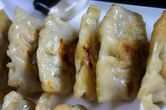
meats. The three are used in many sorts of dishes such as soups or fried foods. Staple vegetables include broccoli, peppers, sesame seeds, mushrooms and turnips. Noodles and rice are the top grains in Chinese-style cooking. Fried Chinese foods are cooked in a versatile round-bottomed vessel known as a wok (Chinese: 镬). Woks can be used for both frying and boiling. One of the most common appetizers in a Chinese meal is a wrapped dumpling dish known as gyoza (Chinese: 饺子) or also called "potstickers". Gyoza is wrapped with thin dough. The fillings for gyoza are mostly made with lean pork and vegetables dipped in a soy-based sauce. Gyoza is often times steamed but can also be boiled and fried, it is mostly fried in western countries. The cuisines of the Sichuan province are spicier than the rest of the cuisines. The
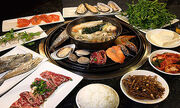
oils used for frying Chinese foods are mostly peanut oil, sesame oil and to a lesser extent, pork oil. Zhe dishes are very low on the use of oil and are generally not greasy foods. Wrapped food is not uncommon in China. Many of these foods are a sweet rice usually blended in with a pork or chicken entrée wrapped in either lotus or banana leaves. Fish balls are a pulverized-food made from fish product that is sold in southern China and mostly overseas Chinese communities. They are most popular in Thailand, Malaysia, Philippines and Vietnam. Vendors usually fry the fish balls on skewers and
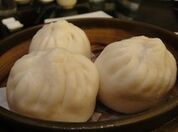
Siopao being steamed in the Philippines
dip them in a hot sauce. Popular type of steamed "sandwiches" snacks in China and other Chinese-influences cuisines in Asia is mantou (Chinese: 饅頭) and siopao (Hokkien: 燒包). Both are made with steamed-buns. The fillings are usually made with sweet meats such as chicken, pork and hard-boiled eggs. The only difference is that mantou is eaten with a spoon and siopao can be eaten on the go since the fillings are completely enveloped in the steamed bread. Similar pastries can be found in China but they are baked. The hot pot (Chinese: 蒙古火锅) is said to have been of Mongol influence, although absent in Mongolia. In a hot pot-sitting, a pot continually boils water in a flavored base. A wide selection of raw foods is laid out for the people, usually only including foods that would have a pleasant taste when boiled. Foods such as tofu, thin-sliced beef, fish balls, fish and various vegetables are often used in hot pots. Pork and chicken are also available. A
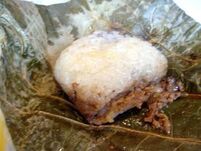
Sweet rice and pork wrapped in lotus leaf
person simply puts the raw food in the pot and waits for the food to boil to a well-done level, this process takes no longer than a few minutes. The base in the hot pot is not to be consumed and is only used for flavoring. Tea and herbal beverages are very traditional to Chinese people, and is also used for medicinal purposes. Chinese desserts are usually made with fruits and various pastes and yams. Beans are also a part of making Chinese desserts. During the Autumnal Equinox, there is a pastry known as moon cakes which is filled with common pastes such as lotus or bean paste. Meats and eggs can also be used for moon cakes. Western utensils such as spoons and forks are not used in Chinese cuisine, unless necessary. Chinese food is traditionally eaten with bamboo chopsticks, which food is picked up from two thin bamboo sticks, about pencil-thick. In case of soups, a
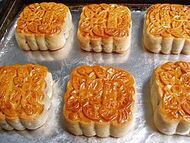
person usually drinks the soup directly from the bowl as if drinking tea. Overseas-Chinese cuisine usually contain a blend of traditional influence and the national culinary traditions of their country. For example, in the Philippines, there is a noodle dish known as pancit canton which is a fusion of Chinese-Cantonese noodles and indigenous ingredients such as liver or pork, a popular meat with Filipinos as a result of Spanish rule. In Malaysia, the Malay dish known as nesi lemak is usually added in with a Chinese twist when sold or made by Malaysian Chinese people. In the United States, most of the Chinese restaurants serve Americanized-dishes that are loosely based on Chinese food such as orange chicken or Mongolian beef. Traditional Chinese orange chicken does not contain breaded-chicken breasts or a sauce that neither thick or sweet. There are crisp-cookies known as fortune cookies that contain little papers of good tidings inside. These are also not found in China, unless they be served at a Chinese-American restaurant, although people claim that the fortune cookie was inspired by the moon cakes.
Notable Han Chinese or People of Han Origin
| Laozi 老子 |
Also known by "Lao Tzu" or "Lao Tze", An ancient Chinese philosapher, author of the Tao Te Ching, and is the founder of the major spiritual religion known as Taoism, he is also a diety in many spiritual religions, he is a popular figure in anti-authoritarian movements |
| Confucius 孔子 |
A teacher, editor, philosapher and politician of the Spring and Autumn Period of Chinese history, his philosaphy - known today as Confucianism (also a religious movement in many respect), promoted government morality, correctness of social justice, and sencirity, his works have been influential all over the world, and have greatly impacted the cultures of the Asia-Pacific rim |
| Gaozu of Han 漢高祖 |
Born as Liu Bang into peasantry, the founder and first emperor of the Han dynasty. Under his rule, he united China, promoted Confucianism as the state religion, reduced taxes and corvée, as well as forging marriage-based relationships with the nomadic Xiongnu Confederation. |
| Zhang Qian 張騫 |
A Han dynasty diplomat, official and travellor who is credited for delivering knowledge to China about the outside civilizations, such as those of Central Asia, India and the Mediterreanean, forging trade with them, he introduced China to global commercial trade and is a national hero in China today |
|
Cao Xueqin |
A Chinese writer and author from the Qing Dynasty known for Dream of the Red Chamber one of China's Great Classical Novels |
|
Chien-Shiung Wu |
A Chinese American physicist who was an expert on radioactivity and helped work on the Manhattan Project, an effort to build atomic weapons to stop Imperial Japan during World War II |
|
Du Fu |
A prominent Chinese poet of the Tang dynasty. Along with Li Bai (Li Po), he is frequently called the greatest of the Chinese poets. His works came to be hugely influential in both Chinese and Japanese literary culture. Of his poetic writing, nearly fifteen hundred poems have been preserved over the ages. He has been called the "Poet-Historian" and the "Poet-Sage" by Chinese critics |
|
Qin Sh'i Huang |
Emperor during China's period of clan-wars known as the Warring States Period, and became the first emperor of a unified China in 221 B.C. |
| Zhang Heng 張衡 |
A Chinese polymath from Nanyang who lived during the Han dynasty. Educated in the capital cities of Luoyang and Chang'an, he achieved success as an astronomer, mathematician, inventor, geographer, cartographer, artist, poet, statesman, and literary scholar. He invented the world's first water-powered armillary sphere to assist astronomical observation; improved the inflow water clock by adding another tank; and invented the world's first seismometer. |
|
Sun Yat-sen |
A Chinese revolutionary who found the democratic Republic of China and became its president and overthrew the Qing Dynasty, although he is considered as one of the most successful leaders of modern China his career dealt with frequent exile and struggle |
|
Lee Kuan Yew |
Singaporean politican, a founding father of modern-day Singapore who was the first prime minister and governed Singapore for three decades |
|
Zhou Xuan |
A Chinese actress and singer who the most popular of seven well-known singers of China and had been dubbed as "The Golden Voice", she recorded more than 200 songs and appeared in over 40 films and movies |
|
Yang Liwei |
A Chinese military pilot of the China National Space Administration and an astronaut that is the first Chinese that was sent into outer space as part of Shenzhou 5 program in which the People's Republic of China became the third country to independantly send humans into outer space |
|
Mao Zedong |
A communist revolutionary and politican from Shaoshan in the Hunan Province who led China to become a communist country, thus founding the People's Republic of China, he was a Stalinist and self-proclaimed true follower of communism, as a result, was responsible for heightened tensions with the Soviet Union, under his leadership, China entered the global stage as a third player in the Cold War |
| Deng Xiaoping 邓小平 |
A Chinese politican was the leader of China from 1978 to 1983, after Mao Zedong's death, he is often regarded as the architect of the modern-day People's Republic of China as it is, as he was responsible for large-scale economic reforms that transition China's practical economy to a market economy, improving the lives for millions of Chinese citizens |
|
Jackie Chan |
An actor, stunt performer, screen writer and entrepenaur from Hong Kong known for his performances in the Rush Hour series and many others, including mixed martial arts movies and has become a popular icon for martial arts movies |
|
Bruce Lee |
A Hong Kong-American martial arts teacher, philosapher, film producer founder of Jeet Kune Do-style martial arts, he is considered by many commentators to be the most influential martial artist and changed the way Asians were presented in films |
|
Yao Ming |
A retired Chinese professional basketball player who played for the Houston Rockets of the National Basketball Association and Shanghai Sharks of the Chinese Basketball Association where he won a CBA Champion in 2002 with the Shanghai Sharks as well as CBA Finals MVP, in his final season with the NBA he was the tallest active player in the NBA |
|
Elaine Chao |
An American politician who served as the 24th United States Secretary of Labor in the Cabinet of then-president George W. Bush from 2001 to 2009, becoming the first Chinese American and Asian American from the Pacific region to become a president's cabinet, she was also a director of the Peace Corps from 1991-1992, she was born in China and became an American citizen |
|
Amy Chua |
An American law professor and social activist at Yale University born to Hokkien parents in Illinois known for writing Battle Hymn of the Tiger Mother |
|
Chiang Kai-shek |
Chinese politician and military leader, who was the leader of the Republic of China from 1928 until his death (to which the Republic of China was exiled to Taiwan), his prominence in international affairs came mostly during the Chinese Civil War, where he was the internationally-supported leader against the communists. He is a national hero in Taiwan and among Chinese nationalists. |
Works Cited
- ↑ https://www.cia.gov/library/publications/the-world-factbook/geos/ch.html#People
- ↑ https://www.cia.gov/library/publications/the-world-factbook/geos/ch.html#People
- ↑ http://www.singstat.gov.sg/pubn/popn/population2011.pdf
- ↑ http://www.thejakartapost.com/news/2012/01/22/racism-remains-chinese-indonesians.html
- ↑ http://www.ocac.gov.tw/english/public/public.asp?selno=1163&no=1163&level=B
- ↑ http://www.state.gov/r/pa/ei/bgn/2777.htm
- ↑ http://www.ocac.gov.tw/english/public/public.asp?selno=1163&no=1163&level=B
- ↑ http://www.ocac.gov.tw/english/public/public.asp?selno=1163&no=1163&level=B
- ↑ http://www.ocac.gov.tw/english/public/public.asp?selno=1163&no=1163&level=B
- ↑ http://www.ocac.gov.tw/english/public/public.asp?selno=1163&no=1163&level=B
- ↑ http://news.xinhuanet.com/english/2008-06/07/content_8324545.htm
- ↑ http://www.ocac.gov.tw/english/public/public.asp?selno=1163&no=1163&level=B
- ↑ http://www.ocac.gov.tw/english/public/public.asp?selno=1163&no=1163&level=B
- ↑ http://www.abs.gov.au/ausstats/abs@.nsf/Lookup/2071.0main+features902012-2013
- ↑ http://www.ocac.gov.tw/english/public/public.asp?selno=1163&no=1163&level=B
- ↑ http://www.travelchinaguide.com/intro/history/xia/
- ↑ http://ancienthistory.about.com/od/china/g/ShangDynasty.htm
- ↑ http://spice.stanford.edu/docs/117
- ↑ http://www.biography.com/people/confucius-9254926
- ↑ http://www.travelchinaguide.com/intro/history/tang
- ↑ http://www.chinahighlights.com/travelguide/china-history/zhu-yuanzhang.htm
- ↑ http://www.travelchinaguide.com/intro/history/ming.htm
- ↑ http://ocp.hul.harvard.edu/immigration/exclusion.html
- ↑ http://en.wikipedia.org/wiki/Battle_of_the_Yalu_River_(1894)
- ↑ http://en.wikipedia.org/wiki/January_28_Incident
- ↑ http://www.globalsecurity.org/military/ops/chinese-civil-war.htm
- ↑ http://www.fas.org/nuke/guide/china/nuke/
- ↑ http://www.americaslibrary.gov/jb/modern/jb_modern_nixchina_2.html
- ↑ http://en.wikipedia.org/wiki/May_1998_Indonesian_riots#Rape_incidents
- ↑ http://www.buddhanet.net/e-learning/history/buddhist-art/chinese_temple.htm%7CA Chinese Buddhist Temple
- ↑ http://library.thinkquest.org/18778/roofs.htm
- ↑ http://www.china.org.cn/english/features/43498.htm




















